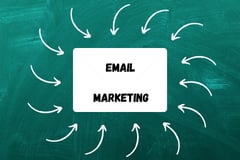Index Content
The term newsletter is made up of the English words news and letter. At first glance, we could understand it as a letter containing news. This is true, but the newsletter is much more than that. Nowadays, the newsletter is a periodic emailing of customers and prospects with content about the company.
The evolution of the newsletter
Although today it is the sending of a periodic email, the newsletter existed before email. Prior to its digitalisation, newsletters were conceived as the physical and also periodic sending of a brochure, leaflet or even a magazine to the home of those subscribers who had given their permission to do so.
In addition to having lost the journalistic tinge with which it emerged, current newsletters have become one of the cheapest methods of communication with customers. The costs of raw materials, printing, transport and delivery have been left aside. Currently they are created with online design programs (not necessarily paid) and sent through specific platforms for sending emails to customer lists such as mailchamp, although the process could also be done manually. In addition, you can create a template on such design pages (such as Canva) and fill it with relevant data for each mailing and, if possible, it can be expanded if needed.
Although it is true that, in terms of effectiveness and reception, the traditional, analogue method has more positive results. The effect of receiving the printed paper and reading it at home is greater than the effect of one more email in the inbox. However, the lower costs compensate for this small difference in the rate of return of the strategy (in addition to the fact that the obvious technological transition in all aspects has forced this change).
Sea como fuere, actualmente se trata de una estrategia más del tan de moda email marketing y que, aunque pudiera reportar algo menos de beneficios que el formato físico, actualmente es una gran táctica de comunicación con el cliente. De hecho, en lo referente a las redes sociales, resulta mucho más eficaz enviar una newsletter con una oferta, por ejemplo, pues su tiempo de vida es superior al de una publicación en redes sociales. Es decir, el tiempo que puede permanecer el email en la bandeja de entrada sin ser visto (y que sea abierto con posterioridad) es superior al tiempo de vida efectivo de una publicación en redes. Un correo electrónico, sobre todo si es periódico y consentido, puede permanecer en la bandeja de entrada durante días intacto y que aún así sea abierto con posterioridad. En cambio, un post en redes sociales pierde su notoriedad a las pocas horas de su publicación, pues se pierde entre la marea de publicaciones de cientos de seguidores. No obstante, redes y newsletter pueden ser
How the newsletter works
As we said, the newsletter is the periodic sending of an email to a list of subscribers. Starting from there, we have to talk first about how this list of subscribers has been created.
The newsletter contact list is created by subscribing to the newsletter from one of the company's channels. Social networks and the brand's websites or online shops are especially effective. In these, an advertisement inviting the user to subscribe to the newsletter usually appears in the form of an advertisement, pop-up or CTA , informing them from the very first moment what the subscription implies: the routine sending of emails to their email addresses and the content of these. Especially in the first contact, the sending of offers and discounts, some of which are exclusive, is highlighted.
When the customer agrees to subscribe, they provide their email address as a minimum, although other information such as their name is usually required. In addition to subscribing to the newsletter, a fundamental conversion in marketing has just taken place: the potential customer has become a lead, a figure of great importance for the company that is nourished by these email notifications.
Once the new customer's email address has been added to the contact list, this person will receive the next newsletter, just like the rest of the customers. How often? That will depend on each company, but they are usually weekly or monthly, although there are also daily (such as media briefings) or fortnightly.
This newsletter can be sent to customers, which is the main target and the one we have talked about so far, but there are also newsletters dedicated to partners and investors, even to the members of the company itself. In other words, although the commercial newsletter is the most common type of newsletter, it is not the only one.
Types of newsletters
Although there is no fixed decalogue on the topics that a newsletter deals with, these are the most frequent ones:
- Informative: They provide information related to the subject matter of the company, for example, the benefits of bread consumption according to a nutritionist if you have a bakery or bakery, the advantages of cotton for your skin if your company is a quality clothing company.
- Corporate information: news and novelties about the company itself, such as the opening of a new office, the taking over of a position by someone, a new product line, the success of a campaign, etc. Even conferences and the company's participation in symposiums, congresses, charity events, etc. It is mainly intended for internal mailings to staff, but it is also included in customer newsletters as it improves the quality of the company's image
- Invitation to action: the user is invited to perform some action such as subscribing to a course, raffles, etc.
- Offers: The customer is notified of offers in the shops (online and/or physical) or is given access to exclusive discounts. Generally these offers tend to be of a personal nature in order to increase the user's return rate and increase sales success.
- News: A catalogue with the latest updates of the company's catalogue is offered
- Occasional campaigns: at special times such as Christmas, summer, Mother's and Father's Day, Valentine's Day or similar, newsletters are usually sent outside the usual period with this special motif, which is usually associated with new products and, above all, new offers.




